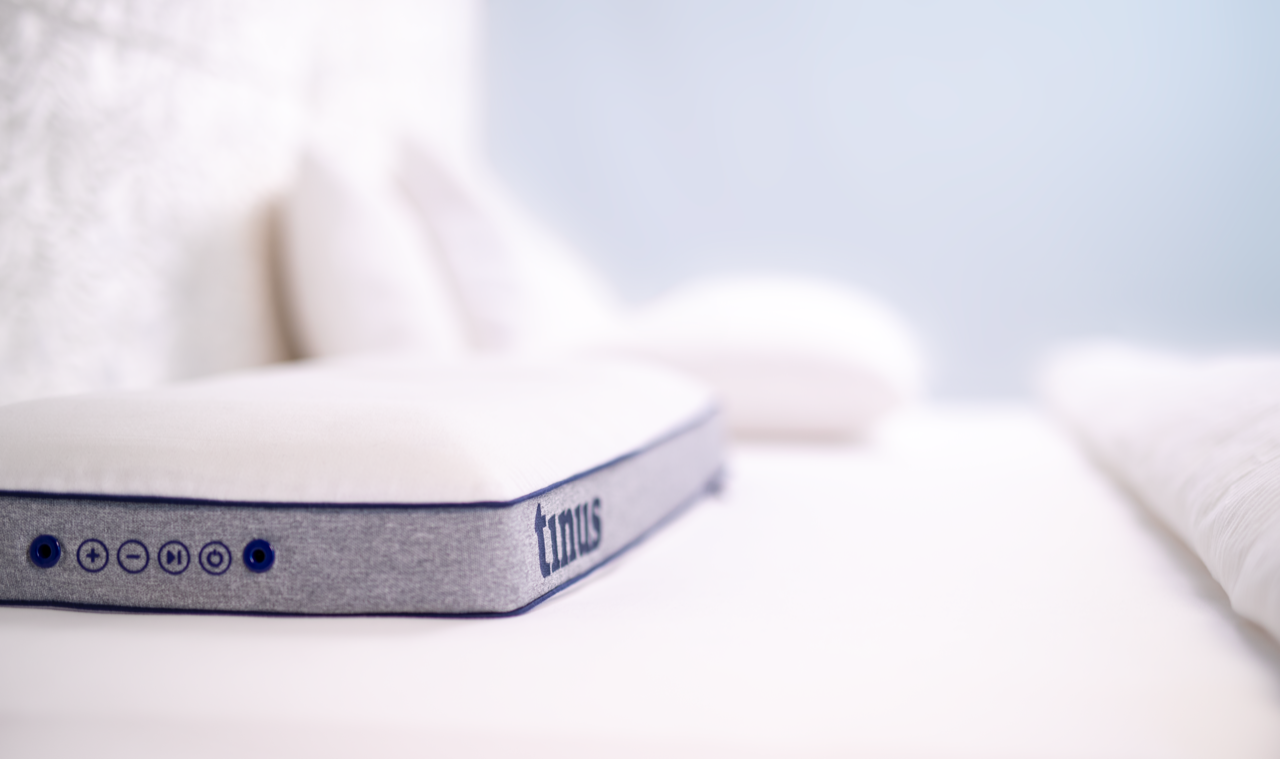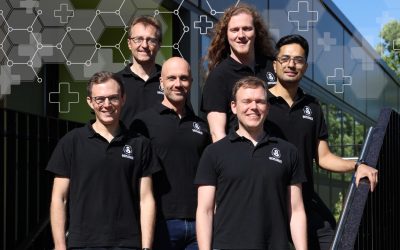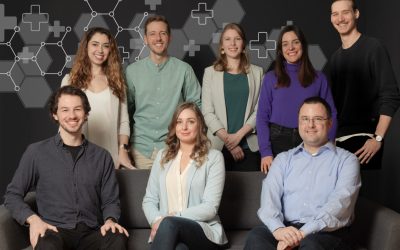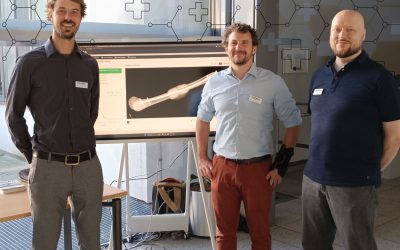Not every product that was originally intended as a medical device actually is one: it depends on the intended use! That’s what the startup tinus learned at the 4C Accelerator. Since their product has no medical purpose, is non-invasive and poses no risk to the user, the team has now realized their product “tinus.one” as a lifestyle product. Simon Greschl, Co-Founder and CTO, was in conversation with us.

Beforehand: Who is behind tinus and what are the goals of your startup?
Simon Greschl: Our goal is to make better sleep accessible to everyone. We came up with this mission through the father of my co-founder. He suffers from sleep disorders due to ringing in his ears. While he needs a radio to fall asleep, this in turn prevented his partner from sleeping. Our initial research showed that this problem is widespread – around 3 million people in Germany suffer from problems falling asleep triggered by ringing in the ears. We would like to help exactly this group of people. Therefore, we pursued our idea – a sleeping aid that transmits sounds not through air but through liquid. Our first prototypes were already promising, and we received a lot of encouragement, so that we have been working full-time on our mission for better sleep since 2020.
Your first product – the “tinus.one” pillow – is now available on the market. What added value does it offer to customers?
SG: tinus.one is characterized above all by three special features:
- The cushion transmits a unique sound quality evenly over the entire surface of the cushion, which has so far provided a WOW effect for everyone.
It does not matter how the users lie on the pillow. The sleeping position can be chosen freely without affecting the sound quality. - At the same time, the tinus.one offers complete sound isolation for the partner in bed. Only the user of the pillow can hear the sounds of the music, while the partner next to them can continue to sleep unaffected.
- In addition, the tinus.one detects when the user is in deep sleep and switches off automatically. This prevents the user from being woken up again by the sounds. In addition, tinus.one has an automatic start-pause function. For example, you can get up and get a glass of water and the podcast is waiting for you. This is made possible by embedded motion sensors that track the users sleep locally on the pillow.
In 2021, your startup participated in the first batch of the 4C Accelerator. What did you take away from this for your business model?
SG: For us, the most exciting thing was learning about the legal and organizational challenges of the medical industry. I studied medical technology, but the focus in my studies was more on the technical than on the regulatory side. Through the 4C Accelerator, I learned how extensive the certification of a medical device is and how much work it entails. With all this input, we then made the decision not to initially realize our product as a medical device, i.e. without a medical purpose, and to launch it on the market.
In a nutshell: What are your top three takeaways from the 4C Accelerator?
SG:
- Scope and scale:
What does a founder have to face, what do I have to realistically plan for, and what investment do I and my team have to take on? - Stumbling blocks from the field:
Reports from other founders have shown us which stumbling blocks can occur, even if you proceed “correctly” according to theory. - Network:
In the 4C Accelerator, we were able to make incredibly valuable contacts, be it with the lecturers, other founders or the MII team.
So you decided to market tinus.one as a lifestyle product. How exactly did that come about?
SG: Originally, I was a strong proponent of realizing and launching our product as a medical device with a specific medical purpose and for a clinical indication. However, we quickly moved away from that plan because our product is basically a sound-based sleep aid and poses no risk to users. Even for a medical device of the lowest risk class, clinical data may be necessary to prove the benefit, in order to be reimbursed by the health care system. Generating such data in a clinical trial can be a lengthy and expensive process. Test users repeatedly asked: The product works, why does it take so long to get the study results? Furthermore, especially as a young company, it is very time-consuming to carry out a full clinical evaluation and to find the necessary money and time for it. My biggest learning from the 4C Accelerator was learning about the regulatory requirements of the MDR and when to apply them. I also learned how lengthy it can be to conduct a clinical trial for proof of benefit.
The bottom line is that we have taken an incredible amount from the program for the development of our business model. In addition, we are now at a point where the clinical evidence for proof of benefit is becoming more and more relevant. That’s why we’re just digging out the documents again, because they still offer a lot of added value for us.
What are the advantages and disadvantages of this strategy?
SG: For the customers themselves, the advantage is that tinus.one is already available on the market. However, despite the high quality, there is no medical certification as a medical device. Customers must therefore convince themselves of the product and try it out. However, the experience of our test users has been positive throughout.
For us as a startup, the decision not to certify tinus.one as a medical device has the advantage that we are much faster and, above all, further along in product development. We can fully focus on the development of a high-quality and safe product without being dependent on third parties. Being dependent on a certified production facility for manufacturing as well would have deprived us of a lot of learning and slowed us down.
Even without medical device status, we practice quality management so that we can ensure a high-quality product. However, the topics of QMS and technical documentation would have been much more extensive in scope if we had decided to go into the medical industry. Because now we are much freer in the choice of materials, for example.
But there are definitely disadvantages as well, especially in the marketing area. We work with several hearing care professionals who sell and recommend our product. They often ask us for the tinus.one aid directory number. While other products, such as hearing aids, have this certification and are subsidized by the insurance companies, we are not eligible for this subsidy.
What would you advise startups that are in a similar situation?
SG: Despite the disadvantages, we at tinus are thoroughly satisfied with our decision. However, other startups facing a similar situation should pay attention to three things in particular:
- Beforehand, the intended use and the potential risk of the product for the users must be thoroughly examined. Only if there is actually no specific medical purpose according to MDR Art. 2, 1 and there is no risk for the users, the variant as a lifestyle product is possible at all.
- Once this has been clarified, the decision for a lifestyle product should be made early in the product cycle. Because then you can build up a lot of speed. If you change your mind late in the cycle, you have a lot of additional work that distracts you from your goal.
- In addition, you have to send a clear message to the outside world. What am I? What is this product? Always being in between makes marketing much more difficult and you might miss both target groups.
What will happen next with tinus? What’s next?
SG: We are currently in the process of scaling our sales and acquiring as many sales partners as possible. The more people who have had tinus.one in their hands, the more the innovation spreads.
On the technical side, we are developing more and more software based on the product and the sleep data. In the near future, we plan to introduce an app that will show sleep tracking the next day, without the need to wear a watch or anything like that while sleeping. Also, as another feature, the alarm clock is supposed to ring via the pillow and not on the smartphone, so that the partner won’t be woken up as well. In general, the combination of sleep input and sound output offers us great potential for further models. This will allow us to create even greater added value for our customers.
Like tinus, startups in the medical life sciences are often faced with the question of whether or not their product is actually a medical device under the Medical Device Regulation. At MII, we can help you get clarity on this. Together, we can review and discuss your intended use and the resulting consequences so that you can find the best strategy for your startup.
When is my product a medical device according to the MDR?
‘Medical device’ means any instrument, apparatus, appliance, software, implant, reagent, material or other article intended by the manufacturer to be used, alone or in combination, for human beings for one or more of the following specific medical purposes:
- diagnosis, prevention, monitoring, prediction, prognosis, treatment or alleviation of disease,
- diagnosis, monitoring, treatment, alleviation of, or compensation for, an injury or disability,
- investigation, replacement or modification of the anatomy or of a physiological or pathological process or state,
- providing information by means of in vitro examination of specimens derived from the human body, including organ, blood and tissue donations,
and which does not achieve its principal intended action by pharmacological, immunological or metabolic means, in or on the human body, but which may be assisted in its function by such means.





